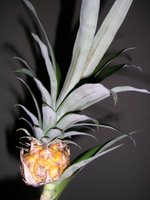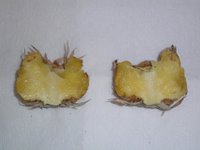 Fran BeaumanThe Pineapple: King of FruitsDecember 2005
Fran BeaumanThe Pineapple: King of FruitsDecember 2005
Chatto & Windus
315 pages
52 illustrations
ISBN: 0-701-17699-7Fran Beauman presents a history of the consumption and cultivation of pineapples, principally in Britain and the United States, from the very late fifteen century to the present day. The book draws extensively from period sources. It is likely that no other author has presented as much historical information about pineapples in a single volume.
The heart of Beauman's book is her account of British pineapple cultivation in the eighteenth and nineteenth centuries. Her pineapple story is one of advancing technology. Progress in heating, horticulture, glass making and other areas led to the construction of remarkably productive private pineapple greenhouses -- "pineapple stoves" or "
pineries" -- with large complexes able to produce hundreds of pineapples per year. Eventually, other technological advances, namely steamships and mechanical refrigeration, made West Indian pineapples cheaply available to Europe and spelled the end of British domestic pineapple production.
Beauman also traces social meanings attached to the pineapple during its early history in Europe and the United States: from royalty to trade to the Church to sex. Most of all, because of the great expense involved in its production, the pineapple was a symbol of wealth and luxury. As Beauman explains, an early hothouse pineapple cost as much as a new carriage. Beauman criticizes the
commonly held idea of the pineapple as a old symbol of hospitality. Rather than a sign of welcome, she argues that the fruit stood more as a self-conscious display of prosperity.
For her book to be of manageable size, some omissions are inevitable and Beauman's history of the pineapple is necessarily incomplete. In particular, her treatment of the pineapple in the twentieth century is much more cursory than that of earlier periods. (One exception is Beauman's tantalizing account of shadowy origins of the
Gold pineapple, a
Smooth Cayenne hybrid developed at the
Pineapple Research Institute variously known as 73-114, MD-2 and CO-2.) She also provides relatively little discussion of the pineapple in Asia (
Taiwan, for example) or
Africa -- major pineapple-producing regions today. Her treatment of South America is limited to the origins of the pineapple (believed to have been domesticated by the Tupi-Guarani people) and Europeans' first introduction to it (Christopher Columbus and his crew).
The one truly heartbreaking omission in
The Pineapple is the lack of a separate description of pineapple varieties, particularly those developed in the old British pineries. Beauman, based on her extensive review of primary sources from the period, gives a glimpse of controversies and rivalries among pineapple gardeners and their patrons regarding cultivation methods. A similarly detailed treatment of the different varieties bred and grown during this special period would have been a wonderful addition to Beauman's work.
 A "lucidus" pineapple plant (Ananas comosus var. lucidus [?]). The plant was in fruit when purchased -- probably by chemical forcing, given the small size of the plant. Complete ripening took about six months from time of purchase.
A "lucidus" pineapple plant (Ananas comosus var. lucidus [?]). The plant was in fruit when purchased -- probably by chemical forcing, given the small size of the plant. Complete ripening took about six months from time of purchase.
 Cross-section of the lucidus fruit with crown removed. The fruit (about the size of a hen's egg) may have been slightly overripe. It was fairly sweet with a pronounced acidity, perhaps the result of winter-time ripening.
Cross-section of the lucidus fruit with crown removed. The fruit (about the size of a hen's egg) may have been slightly overripe. It was fairly sweet with a pronounced acidity, perhaps the result of winter-time ripening.

